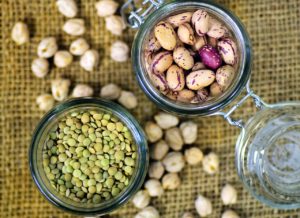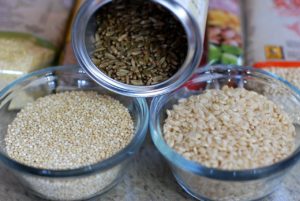Ketogenic (or keto) and paleo diets are two recent carb-restricted dietary trends that are claimed to provide health benefits including weight loss, improving biomarkers associated with heart disease and type 2 diabetes (e.g. triglyceride levels, blood pressure, blood glucose levels).
A keto diet is very low in carbs (<5% in strict keto diets) and high in fats including saturated fats, with the goal of promoting the body to go into a state of ketosis, i.e., burning fats instead of glucose as the primary source of energy.
A paleo diet does not have strict restriction on the proportion of carbohydrates. However, the diet is relatively high in proteins and excludes dairy, grains and legumes. It is based on the theory of eating according to our ancestors during the Paleolithic era (~2.5 million to 10,000 years ago), i.e. the hunter-gatherer era before farming was introduced. A paleo diet typically consists of fruits, vegetables, fish, lean meats, nuts and seeds.
Let’s take a look at the scientific evidence from clinical research, i.e., research based on human study subjects.
Clinical Research on Dietary Composition of Carbohydrates
The most well-studied diets in clinical research in the past decades are the whole food based traditional Mediterranean diet, vegetarian diets and vegan diets or some variations of these diets. These clinical research include population studies conducted on different regions and cultural groups at different parts of the world as well as clinical trials.
Comparatively, clinical research on paleo diets and keto diets are much more recent and still limited.
Strong and congruent evidence from existing clinical research have shown that whole food plant-rich diets including the traditional Mediterranean diet, vegetarian diets and vegan diets are beneficial in preventing and managing chronic diseases including type 2 diabetes, high blood pressure, heart disease, Alzheimer’s disease and dementia, and cancers.
(For more specific details and background on the clinical research findings, please check out my articles on Diets and Chronic Diseases in www.simplyradiantliving.com/nutrition).
The main commonalities of these beneficial diets include:
- Emphasis on the consumption of whole foods (i.e., foods in their natural forms) and avoidance of processed and refined foods.
- Rich in plant-based foods and complex carbohydrates (~ 50-75% of complex carbohydrates), with primary emphasis on whole fruits and vegetables, and moderate amount of legumes and whole grains.
- Low-to-moderate amount of healthy fats, including monounsaturated fats (e.g. olive, avocado), omega-3 polyunsaturated fats (e.g. cold-water fish, flaxseed, chia seed, some nuts and seeds), MCT oil (e.g. coconut oil).
- Low-to-moderate amount of healthy proteins, e.g. legumes, quinoa, brown rice, hemp seeds, and healthy fish, meat.
- Limited consumption of red meat, processed meat and saturated fats.
- Avoidance of trans fats and pro-inflammatory omega-6 polyunsaturated fats from extracted vegetables oils including corn, soybean, sunflower and cottonseed oils.
Evidence from clinical research thus far showed that carbohydrates itself is not the problem but rather the types of carbohydrates one consumes.
Not All Carbs are Created Equal
Carbs have been portrayed a negative image because it can cause spikes and elevation of blood glucose levels and increase insulin levels, which in turn can contribute to inflammation, weight gain, obesity and other chronic diseases.
However, it is refined carbohydrates that is the culprit.
Refined Carbohydrates
Refined carbohydrates such as white rice, white flour, white/refined sugars, refined grains, processed starch, and any food products that  contain these ingredients, are stripped of fibers and other important plant nutrients (phytonutrients).
contain these ingredients, are stripped of fibers and other important plant nutrients (phytonutrients).
Refined carbohydrates are effectively empty calories, i.e. calories with not much beneficial nutrients. They are digested and absorbed quickly into the blood stream, thus causing spikes in blood glucose levels.
Refined carbohydrates are prevalent and found it most processed foods (e.g., cookies and other bakery and snacks, white breads, desserts, sugary drinks, added sugars in foods, fast foods, etc.).
Complex Carbohydrates
 Complex carbohydrates from whole fruits, vegetables, legumes and whole grains, on the other hand, are rich in fibers and many types of nutrients, which slow the digestion and absorption of glucose into the blood stream.
Complex carbohydrates from whole fruits, vegetables, legumes and whole grains, on the other hand, are rich in fibers and many types of nutrients, which slow the digestion and absorption of glucose into the blood stream.
Both soluble and insoluble fibers in complex carbohydrates have been shown to be beneficial for the  prevention and management of type 2 diabetes and insulin resistance. Insulin resistance is a common culprit to many chronic diseases, including type 2 diabetes, heart disease and cognitive decline.1
prevention and management of type 2 diabetes and insulin resistance. Insulin resistance is a common culprit to many chronic diseases, including type 2 diabetes, heart disease and cognitive decline.1
Complex carbohydrates are also rich in vitamins, minerals and phytonutrients that have antioxidation, anti-inflammatory and  other health promoting properties, which are beneficial for disease prevention and management.2,3
other health promoting properties, which are beneficial for disease prevention and management.2,3
Therefore, consuming the right types of carbohydrates is important!
How to Choose the Right Types of Carbohydrates?
There are several rules of thumb one could follow.
Rule #1: Consume Whole Foods and Avoid Refined Carbohydrates
The importance of consuming whole foods cannot be over-emphasized!
The simple rule of thumb is to avoid processed foods and refined carbohydrates. If processed foods cannot be avoided, choose those made with whole food ingredients only and without food additives, e.g. cookies or bakery made with whole grains.
Rule #2: Consume a Wide Variety of Complex Carbohydrates
Plants have phytonutrients that have been shown to exhibit anti-oxidation, anti-inflammatory, anti-cancer, hormone regulating and other health promoting effects. 1,3
Thousands of phytonutrients have been identified so far. Beta-carotene, lycopene, lutein, resveratrol, anthocyanidins, flavonoids, isoflavones are some of the more well-known phytonutrients.
To obtain various health promoting properties of phytonutrients, it is important to consume a wide variety and rainbow colors of whole fruits, vegetables and legumes.
Rule #3: Avoid Added Sugars
 Many processed foods and packaged/pre-made foods are laden with added sugars. Although brown sugar is somewhat better than white sugar, it is still highly processed and stripped of nutrients.
Many processed foods and packaged/pre-made foods are laden with added sugars. Although brown sugar is somewhat better than white sugar, it is still highly processed and stripped of nutrients.
If added sweeteners cannot be avoided, natural sweeteners such as dates, maple syrup and honey are better choices. These natural sweeteners consist of health promoting nutrients and phytonutrients, rather than empty calories.
Rule #4: Choose Low Glycemic Carbohydrates
Glycemic index (GI) of a food is a measure of how much 50g of carbohydrates in the food raises blood glucose levels after it is consumed. However, GI alone does not account for the actual amount of carbohydrates in a typical serving size of a particular food.4
A more relevant measure is called the Glycemic Load (GL) which accounts for both the raw GI value and the actual amount of carbohydrates in the food. GL is defined as (GI × available carbohydrate (g) per serving/100). 4
The general guideline for low glycemic foods is foods that have GI of 55 or lower, or GL of 10 or lower. Low GI and GL diets have been shown to reduce the risk of chronic diseases.5
Complex carbohydrates from whole foods generally have lower GI and GL compared to refined/processed carbohydrates.
A good resource for GI and GL values of different types of foods is the GI database maintained by a research group in the University of Sydney (http://www.glycemicindex.com/index.php).
Rule #5: If Foods Higher in GI or GL are Consumed, Combine Such Foods with Foods Low in GI/GL, Rich in Fibers, Healthy Proteins and Healthy Fats
Afterall, it is the overall GL of a meal that really affects how quickly glucose are digested and absorbed into the blood stream.
Fibers, proteins and fats can slow the digestion and absorption of glucose.1,6
However, the types of proteins and fats can have big influence on the blood glucose and insulin response. Proteins are more effective in lowering post-meal blood glucose levels than fats. In addition, saturated fats and trans fats can promote insulin resistance.
Plant proteins are more effective in lowering post-meal blood glucose levels compared to animal proteins. Although animal proteins can also lower post-meal blood glucose levels, it is at the expense of increased insulin levels.6,7 In addition, consumption of red meats and processed meats have been associated with increased risk of type 2 diabetes, heart disease and other chronic diseases.8
Rule #6: Use a Glucometer to Measure Fasting Blood Glucose Levels
Because of individual’s uniqueness in digestion, absorption and metabolism, to more accurately measure the blood glucose effect of a meal, one could use a glucometer to measure the fasting blood glucose level about 3 to 4 hours after a meal, i.e. after foods have been fully digested.
Ideally, fasting blood glucose level should be kept around 70-90 mg/dL (or 3.9-5.0 mmol/L), although individual’s range may vary. Glucometer reading can be a useful feedback for one to adjust and fine-tune the meal composition, in order to bring the blood glucose level within range.
Using a glucometer to closely monitor fasting blood glucose level can be particularly useful for people who are at risk or susceptible to diseases associated with elevated blood glucose and insulin levels including prediabetes, type 2 diabetes, high blood pressure, heart disease, cognitive decline, dementia and Alzheimer’s disease, and cancers.
(For more details on the risk factors associated with chronic diseases, please check out my articles on Diets and Chronic Diseases in www.simplyradiantliving.com/nutrition.)
What About Keto and Paleo Diets?
Keto Diets
A strict keto diet limits the consumption of carbohydrates to less than 5%, in conjunction with high fat consumption. A keto diet promotes the body to go into ketosis (thus using fat metabolites as alternative fuel for the brain) and has been historically used as a therapeutic diet for epilepsy since around 1920s.13
More recently, keto diets have been shown in clinical studies to improve glycemic control and other biomarkers associated with type 2 diabetes because of strict restriction of carbohydrates, thus GI and GL. Keto diets have also been shown to be beneficial for other chronic diseases including heart disease, cancers, dementia/Alzheimer’s disease and other neurological diseases.9
However, clinical studies especially clinical trials on keto diets for various chronic diseases are more recent and limited in size and duration.
The potential issue of a keto diet is the severe lack of the beneficial nutrients and phytonutrients found in whole plant foods. A keto diet is also high in fats including saturated fats.
Although short-term therapeutic use of a keto diet may be beneficial, long-term sustainability and health effects of adopting a keto diet is yet to be proven. Nutritional supplements may be needed to substitute for the missing nutrients and phytonutrients in whole plant foods.
Paleo Diets
A paleo diet also emphasizes on whole foods including up to 45% of complex and low glycemic carbohydrates from whole fruits and vegetables, up to 35% of proteins from unprocessed lean meats and fish, and low-to-moderate amount of healthy fats (e.g., nuts, seeds, olive oil, avocado).10
Therefore, to a large extent, a paleo diet shares some commonalities with a whole food plant-rich diet discussed above. The main exceptions are the relatively larger proportion of proteins mainly from animal proteins, and void of whole grains and legumes in a paleo diet.
Clinical studies especially clinical trials on paleo diets are more recent and limited in size and duration. The proportion of carbohydrates from whole fruits and vegetables and the proportion of animal proteins also vary in these clinical trials.
Most of the studies showed the benefits of paleo diets in improving the biomarkers associated with chronic diseases, when compared with some control (or reference) diets. It is important to note that the control diets used in these studies do not specifically restrict processed/refined foods and high GI or GL foods.11,12
Therefore, the benefits of paleo diets may be attributed to the emphasis of whole and low glycemic fruits and vegetables, low in pro-inflammatory omega-6 fats, and void of processed foods. 11,12
The benefits of strictly avoiding whole grains and legumes have not been clearly elicited in the existing studies.
Some people with gut dysfunction and associated food sensitivity/intolerance and autoimmune disorders may find avoiding certain grains or legumes lead to reduction in symptoms and improved health conditions. In such cases, it is important to address the underlying gut dysfunction. (See more details in Why Your Gut Feeling Matters and Simple Guidelines for Healthy Eating.)
Related Articles
Simple Guidelines for Healthy Eating
Diets and Chronic Disease (Part 1: Type 2 Diabetes)
Diets and Chronic Disease (Part 2: High Blood Pressure)
Diets and Chronic Disease (Part 3: Heart Disease)
Diets and Chronic Disease (Part 4: Alzheimer’s Disease)
Diets and Chronic Disease (Part 5: Cancer)
References
- Weickert M, Pfeiffer A. Impact of Dietary Fiber Consumption on Insulin Resistance and the Prevention of Type 2 Diabetes. J Nutr. 2018;148(1):7-12. doi:10.1093/jn/nxx008
- Rodriguez-Casado A. The Health Potential of Fruits and Vegetables Phytochemicals: Notable Examples. Crit Rev Food Sci Nutr. 2014;56(7):1097-1107. doi:10.1080/10408398.2012.755149
- Zhu F, Du B, Xu B. Anti-inflammatory effects of phytochemicals from fruits, vegetables, and food legumes: A review. Crit Rev Food Sci Nutr. 2017;58(8):1260-1270. doi:10.1080/10408398.2016.1251390
- Monro J, Shaw M. Glycemic impact, glycemic glucose equivalents, glycemic index, and glycemic load: definitions, distinctions, and implications. Am J Clin Nutr. 2008;87(1):237S-243S. doi:10.1093/ajcn/87.1.237s
- Augustin L, Kendall C, Jenkins D et al. Glycemic index, glycemic load and glycemic response: An International Scientific Consensus Summit from the International Carbohydrate Quality Consortium (ICQC). Nutrition, Metabolism and Cardiovascular Diseases. 2015;25(9):795-815. doi:10.1016/j.numecd.2015.05.005
- Hätönen K, Virtamo J, Eriksson J, Sinkko H, Sundvall J, Valsta L. Protein and fat modify the glycaemic and insulinaemic responses to a mashed potato-based meal. British Journal of Nutrition. 2011;106(02):248-253. doi:10.1017/s0007114511000080
- Quek R, Bi X, Henry C. Impact of protein-rich meals on glycaemic response of rice. British Journal of Nutrition. 2016;115(07):1194-1201. doi:10.1017/s0007114515005498
- Estadella D, da Penha Oller do Nascimento C, Oyama L, Ribeiro E, Dâmaso A, de Piano A. Lipotoxicity: Effects of Dietary Saturated and Transfatty Acids. Mediators Inflamm. 2013;2013:1-13. doi:10.1155/2013/137579
- Paoli A, Rubini A, Volek JS, Grimaldi KA. Beyond weight loss: a review of the therapeutic uses of very-low-carbohydrate (ketogenic) diets. Eur J Clin Nutr. 2013;67(8):789-96.
- Cordain L. The Paleo Diet®. The Paleo Diet™. https://thepaleodiet.com/. Published 2019.
- Manheimer EW, van Zuuren EJ, Fedorowicz Z, Pijl H. Paleolithic nutrition for metabolic syndrome: systematic review and meta-analysis. Am J Clin Nutr. 2015;102(4):922-32.
- Pitt C. Cutting through the Paleo hype: The evidence for the Palaeolithic diet. Australian Family Physician. 2016;45(1):35-38.
- Dhamija R, Eckert S, Wirrell E. Ketogenic Diet. The Canadian Journal of Neurological Sciences. 2013;40(02):158-167. doi:10.1017/s0317167100013676


